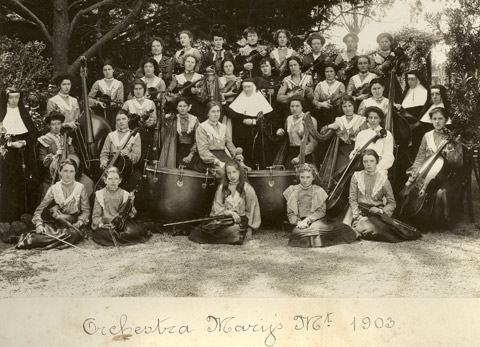
Girls’ orchestra, Mary’s Mount (Loreto College), Ballarat, Victoria, 1903. Source: National Museum of Australia
Rachel McDonagh ~ Michael Keogh ~ Abigail Richardson ~ Meg O’ Brien
By the nineteenth century, the people of the Australian colonies began to realise that crime was the result of a lack of education. Education was used as a means of creating an organised and orderly society out of the penal colonies.[1]
The treatment of the Irish in colonial Australia’s education sector during the long nineteenth century is an important area of study – and can be achieved through a primary source analysis. Newspaper articles provide information about the mindset of Australians and how they viewed education. Along with these, details of the education acts throughout the years aid in further expanding our knowledge on the colonial mentalité and individual opinions about education. Discrimination is a factor that has come to the surface of the following study in various ways. It is evident that many Irish people were discriminated against throughout the history of European settlement in Australia – and in its historiography. Each page of this website section has set out to detail the various ways Irish emigrants have flourished – and suffered – within the education sector. Specifically, the themes of gender and religion have been focused on in detailing how the Irish emigrants faced discrimination both as educators and students.
For examining gender roles within the education sector, an analysis of the female teacher’s impact on Queensland’s education has provided an abundance of evidence. To contrast the female experience and to provide context regarding the Irish male teacher, the role and influence of Irish convict educators in New South Wales is also important. The primary sources regarding these topics have allowed for questioning the idea that the Irish were merely convicts, and so were ‘generally depraved and the cause of so much disorder’.[2] Using articles and advertisements around a specific female institution in Brisbane, women’s education will be discussed, while focusing on specific female and male teachers in Queensland and New South Wales enable an understanding of Irish contributions.
When studying the historiography of the Irish educational experience in colonial Australia one could say that, in conjunction with the primary source material, the secondary source material is insufficient in portraying these Irish people and their influence. The Brisbane Girl’s Grammar School and the Castlereagh Classical Academy have surfaced as important points of reference in displaying how the Irish engaged with the education sector as students and teachers, questions of ‘public’ and ‘private’ education also emerge.[3] Examining Earl Grey’s Irish orphan scheme is useful for understanding the ways that the orphaned Irish emigrants were educated; orphans made up a significant portion of the Irish population in some of the colonies.
Religion surfaces as an underlying theme. As a British territory, Australia was officially Protestant (Anglican). This often led to the harsh treatment of Catholics and sometimes, the Irish population, more generally. An examination of how religion brought about discrimination for certain Irish people will be done through an analysis of selected Catholic schools. In looking at such schools, a focus will be placed on how early colonial legislation inhibited growth and organisation. Also, regarding the theme of religion, the experiences of Irish Protestant convict educators and Irish Catholic educators will be compared.
REFERENCES
[1] Marion McCreadie, ‘The evolution of education in Australia’, 2006, Internet Family History Association of Australia: Australian Schools (http://www.historyaustralia.org.au/ifhaa/schools/evelutio.htm) (4 Apr. 2017).
[2] Joy Damousi, ‘Depravity and disorder: the sexuality of convict women’ in Labour History, 68 (1995), p. 30.
[3] Craig Campbell, ‘Public and private in Australian schooling: Australia 1788-2010’ Dictionary of Educational History in Australia and New Zealand (DEHANZ) (http://dehanz.net.au/entries/public-private-australian-schooling/) (4 Apr. 2017).